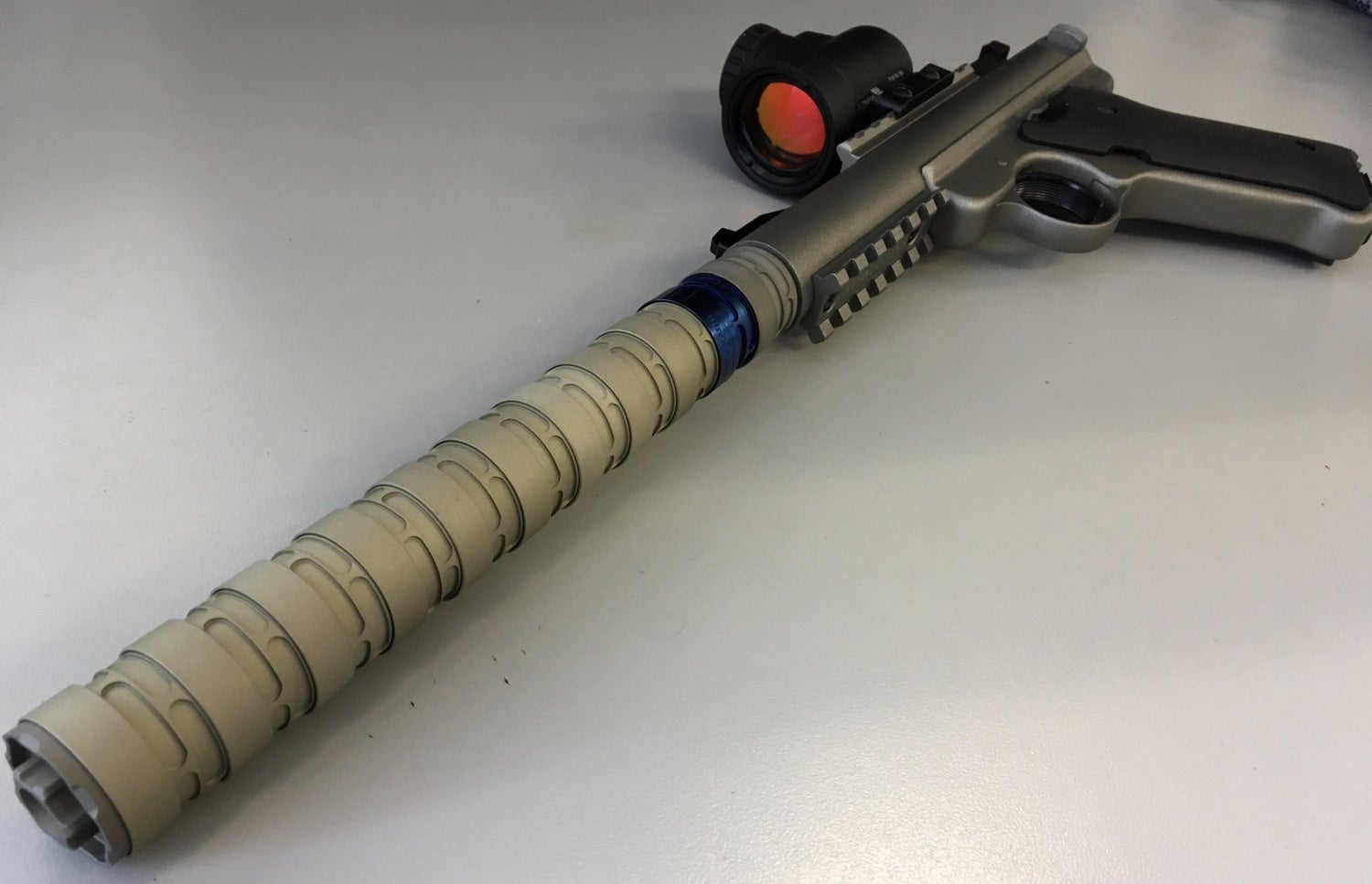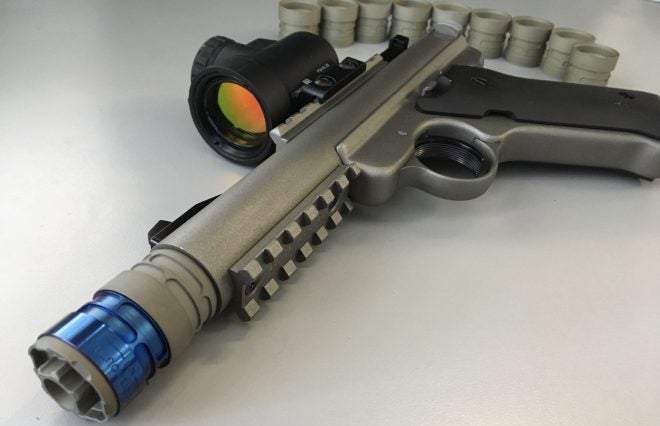For decades silencers have consisted of a single tube with internal baffle sections sandwiched between two endcaps, one designed to mount onto the host firearm the other designed to be the business end. However a chain of historical, technological and economical events (along with the work of some big brains) have allowed manufacturers to get creative with overall silencer design. Branded as Modular Silencers, companies have developed ways to build suppressors that can be broken down into smaller sections, creating a variable length device.
One of the keys to legality of these “multi-length” silencers is that, no matter what configuration is used, the combination of the original parts can only be assembled into one device at a time. Meaning the “extra parts” remaining after assembly cannot be assembled into a second suppressor.

Q Erector

Q Erector
With all of the modular models of suppressors hitting the market, the ATF is set to make a determination on the the rules/regulations surrounding these configurable cans. At the top of the list will surely be ‘spare parts’ which you probably all know by now are not allowed without paying additional NFA taxes (silencer parts = silencers). For example, a manufacturer can’t sell you extra baffles without the need for an ATF Form 4 transfer application and you having to pay $200 for each individual part.
By design, modular silencers do not have spare parts; if used in a short configuration, there may be unused parts, however the same set of circumstances can be crated with a traditional silencer and removing internal baffles.
Also, sure to be included in the official discussions will be the length and caliber values as noted in the registry. These measurements need to be specific and cannot (currently) include variable length ranges and multiple calibers designations.
A recently expired patent filled by Heckler & Koch over twenty years ago examined the application of modular silencers. (Much thanks to Q Engineer Ethan Lessard for the technical guidance). To my knowledge, H&K never sold a modular firearm suppressor under this patent. But, with it’s expiration, numerous companies have brought configurable suppressors to market.
Heckler & Koch – Patent 5679916 – Modular Silencers
FIELD OF THE INVENTION
This known silencer consists of an attachment piece that can be attached to the muzzle of a weapon, of an end piece, and, in between, of a series of rings that are successively placed in a centered manner, and that form the outer wall of the silencer, and between each of which a dividing wall featuring a firing opening is set, thus forming successive chambers.
The individual rings differ from each other in terms of their length so that only one single, specific ring is associated with each longitudinal segment of the silencer.
It is known from FR-8-323 574 (HUMBERT) that the structural members that constitute the individual chambers can be arranged within a common outer barrel.
***
Overall, a silencer should always be as short as possible. This is because it increases the total length of the firearm that has been painstakingly shortened by other design means, and it furthermore adds weight to the muzzle, thus impairing the weapon’s balance.
Although different weapons may have the same caliber and muzzle shapes, it is still necessary to manufacture and stock many silencers with different lengths, in order to meet all requirements. This heavy expenditure is a disadvantage.
The invention’s task is to improve the initially mentioned, known silencer in such a way that it can be adapted to the particular requirements with minor effort.
The invention solves this problem by means of the object of claim 1, which means an object in which the features of this class are combined with the other features, i.e., each chamber part is attached according to a modular principle directly to the adjoining chamber part, and the outer walls of the successive chamber parts form the outer wall of the silencer.
The successive outer walls of the chamber parts thus form the silencer’s outer wall. The jacket tube necessary for the known silencer is thus eliminated.
SUMMARY OF THE INVENTION
In the silencer according to the invention, the individual chamber parts can be connected to each other, to the attachment piece, and/or to the end piece, for instance, by resistance welding. Parts with a non-circular cross-section also can be connected to each other in this way.
Major American companies with modular silencers:
- Dead Air Armament
- Gemtech
- Griffin Armament
- KGMade Silencers
- Q
- Rugged Suppressors
- SilencerCo
- Surefire
- Thompson Machine

Q – Prototype of the pistol caliber Erector.
Joshua Prince of the Prince Law Firm and Blog recently posted the news about the upcoming ATF ruling/determination/guidance while attending the NSSF/FAIR Trade Group’s 16th Annual Firearms Import/Export Conference at a round table discussion with the Firearms and Ammunition Technology Division (FATD):
Prince Law Blog
Second, in relation to modular silencers, FATD acknowledged that it currently has pending before it a request for determination of legality from a modular silencer manufacture. Division Chief Griffith and Branch Chief Curtis raised concern over the determination request and the issues that must be addressed, including whether modular silencer are legal, when reduced in size. In essence, the concern stems from there arguably existing additional silencer parts that are not part of the modular silencer’s configuration, when it is reduced in length. In the event that ATF would rule that modular silencers are generally lawful, it raises a plethora of other issues, including where the markings must be placed (which is interrelated to ATF’s currently pending rulemaking: ATF-29P) or whether such silencers would require either specific location markings or multiple markings.
Although ATF was reluctant to state whether these determinations would be in the form of “policy determinations,” “guidance” or “formal rulings,” and stated that it could not provide an exact timeframe for these determinations, it was stated that they are overdue and should be expected in the very near future.
And, because their is a proposed rule change regarding the location of markings on silencers that could have an effect on modular devices, here’s a link to TFB’s coverage from last year.
TFB Covered the announcement of Rule Proposal 29P last year:

So, what is the future of modular silencers? Who knows.
Would I be concerned with buying any of the current configurable cans on the market? Nope.
Even if the ATF decides a rule change is required, silencers already in the hands of shooters should be grandfathered and users not required to pay additional tax. Besides, I don’t see the ATF making a dramatic ruling against modular silencers at the moment – ownership is at historic highs with more and more silencers in the hands of new shooters every year and at least some of ATF’s leadership want to see them removed from the NFA entirely.
Exciting times.
***
[Author] – Additional information added 8/12/2017 from the American Suppressor Association:
STATEMENT REGARDING POTENTIAL ATF DETERMINATION ON MODULAR SUPPRESSORS
ATLANTA, GA – Over the past week, multiple claims have stated that the BATFE’s Firearms and Ammunition Technology Division (FATD) is in the process of issuing an industry wide determination on the legality of modular suppressors. After speaking at length to several of our contacts within ATF, ASA has concluded that these assertions stem from misinterpreted comments made by ATF officials at a recent industry conference. According to our contacts at ATF, these are the facts related to three separate areas of discussion:
Modular Suppressor Design – FATD is in the process of reviewing a request from an independent industry representative regarding a single, specific modular suppressor design. The representative is seeking a determination regarding their specific product, not a blanket determination that would apply to other existing modular designs. The issue in question is whether or not the suppressor being reviewed has the ability to assemble more than one functional suppressor out of the component parts that are supplied as a single suppressor to the end-user.
ATF 29P – On May 4, 2016, ATF published an Advance Notice of Proposed Rulemaking (ANPRM) in response to an eight year old request by the National Firearms Act Trade & Collectors Association (NFATCA) made in 2008. In the ANPRM, ATF sought to specify that manufacturers must mark the outer tube of suppressors, not just any externally visible part. The ASA, along with many members of the industry, submitted comments to the ATF opposing ATF 29P. We have been told by ATF that 29P is no longer being worked on by the Bureau, as many current suppressor designs without an outer tube have made the proposed rules within 29P obsolete.
NFA Handbook – The NFA Division and Firearms & Explosives Industry Division are working on a long overdue update to the NFA Handbook. Within the updated handbook, new language will be included that addresses the repair or replacement of modular suppressor components. This language will be consistent with previously published guidance, which states that the serialized component of a suppressor cannot be replaced without the filing of a new Form 2 by the manufacturer, and a new Form 4 by the consumer, including the payment of applicable transfer taxes. Unmarked components of a modular suppressor may be replaced by a licensed manufacturer on a one-for-one basis, just as previously allowed in the silencer FAQ published by ATF on April 17, 2008.
In summation, there are currently no widespread determinations set to be issued by ATF with regards to modular suppressors.
 Your Privacy Choices
Your Privacy Choices
